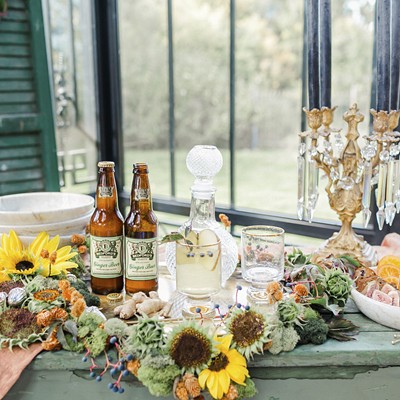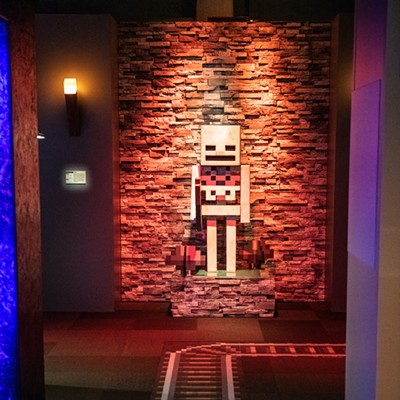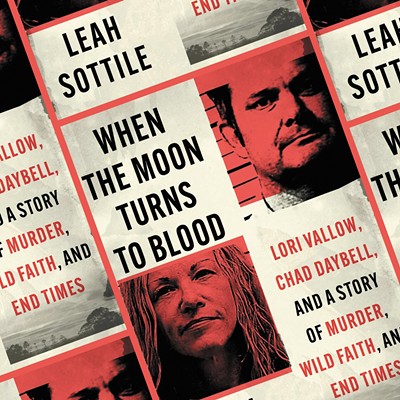It’s Wednesday night at the Spike. Despite the fresh snow and freezing cold, seven women (including myself) have made it downtown and are now claiming the best corner of the coffee shop – the one with the best chairs and the funky blue light. Shyly, each takes from her bag a ball or two of yarn and a pair of needles and – with a bit of small talk or a surreptitious glance at her neighbor’s project – begins to knit. Tonight’s Stitch ‘n’ Bitchers are young – most are in their 20s and 30s – and conversation ranges from what everyone does for a living to how plastic needles in larger sizes look like sex toys. Overhead, the Pixies are playing on the Spike’s Internet radio station and the heady bittersweet aroma of just-pulled espresso fills the air.
Inspired by similar “Stitch ‘n’ Bitch” gatherings in Chicago and New York, Spokane’s newest knitting group is off to a convivial start. It feels good to be out tonight. In addition to our group, there’s some kind of rock thing going in the new “underground” space adjoining the café. And lest you mistake this for some sort of old-fashioned knitting circle complete with polite chit-chat and doilies-in-progress, it should be mentioned that many members are fond of the “f” word and employ it liberally while, say, untangling a hissing snarl of yarn or realizing one’s scarf has a big ugly dropped stitch or purls where there ought to be knits.
In fact, our Stitch ‘n’ Bitch is actually part of a revolution. Yes, a revolution. The “girly” arts – knitting, cleaning, cooking, sewing and crafts – are making a big comeback. It’s not for nothing that Bust magazine editor and Stitch ‘n’ Bitch author Debbie Stoller proclaims that "crafting is the new rock ‘n’ roll." Magazines like Ready Made routinely sell out at area newsstands.
While the movement has been quietly simmering in the background for several years now, it took Jean Railla and her book Get Crafty: Hip Home Ec to pop it on the front burner and set it on high. Railla’s Web site < www.getcrafty.com > carries her “manifesto,” a deliciously worded essay on how she, an authority-questioning Third Wave feminist and chain-smoking bohemian, finally found depth and meaning in the unlikeliest of places – in cookbooks, yarn, and cleaning.
“When I was younger, I saw crafts as sort of anti-intellectual. I think that’s why I shunned them for so long,” Railla admits. Instead, she devoted her time to women’s studies and worked on her documentary Five Nights Out, which covered L.A.’s early indie music scene and spotlighted Beck at the beginning of his career. She started a zine called Crafty Lady in 1997 but even then, she was defining crafts as a particularly punk rock thing to do. Now that the domestic arts are being embraced by the post-Martha generations, Railla is thrilled to see that her previously secret passions are suddenly, well, hip.
“I think this is one of the successes of feminism in fact, that young women feel so strongly about themselves that they can knit and be taken seriously.”
Railla calls the growing popularity of what was previously considered women’s work “the new domesticity,” and her book is rife not only with recipes (including her grandmother’s superb Madeleines) and “how to” information but also with a smart, lively articulation of what “the new domesticity” is.
“The new domesticity embraces traditional women’s work, yet it is not traditional. That’s an important distinction,” she says. “Just because I knit doesn’t mean I do all the housework. It’s not conservative.”
“More Urban Than Suburban”
Like many struggling New York artists, Nava Lubelski was always figuring out good ways to live on the cheap yet live well. It helped that her loft (and here we’re talking about the unfancy kind) was situated in an industrial neighborhood where the day workers filled the dumpsters with interesting reusables and the night denizens were often artists like herself.
“We were talking about art and our lives and making our environments more livable. To be honest, I didn’t like Martha Stewart. I could appreciate the need to personalize one’s environment, but what she was doing always seemed kind of alien to me. I thought it was kind of a funny idea to take her kind of thing but infuse it with this sort of DIY/starving artist/bohemian energy.”
And that’s exactly what Lubelski did. Her book The Starving Artist’s Way is full of cheap domestic projects, clever salvage tricks, mostly vegan recipes and most importantly, sidebars on famous and not-so-famous 20th-century artists whose works inspired or informed Lubelski’s ideas.
“I always tell people that the starving artist’s way doesn’t have to be elaborate. It’s when you go to a friend’s house for dinner and all they’ve got to work with is a can of tuna but they somehow concoct something magical with it. Or I have this other friend who combines all these different shapes of pasta. It’s very simple but his pasta dishes are always wild and fun. It’s completely different from that sort of Depression-era mindset where you just eat what comes out of the box.”
The aesthetic of the New Domesticity is an important part of what defines it. While it can be as pink and feminine as a 1950s-era plush toilet seat cover, the New Domesticity is often kitschy and resourceful. While it’s always tempting to blow half your food budget on imported yarns – and a lot of us do – there are cheaper ways to get your goods.
“It’s all about reinvention. It’s taking old sweaters you find at the thrift store and shrinking them into something you can cut and sew together,” says Railla. “It’s more Salvation Army than Michael’s, it’s more urban than suburban. It’s about the personalization of your environment and your experience in a world of consumerization and mass manufacturing.”
Lubelski also points to the New Domesticity’s “art-smart” attitude.
“What I see happening with this movement is art and craft coming together. This hasn’t been happening in a vacuum. There are artists like Mike Kelly who did that little crocheted figure for Sonic Youth’s Dirty album. Crochet and knit have always seemed kind of uncultured so for art -- it was kind of like discovering new terrain. And for years I’ve seen young people crocheting on the subway squeezed in between every imaginable kind of New Yorker. It’s intellectual in a new way. This is not about kitty cats and roses.”
Reworking Gender
There’s no doubt that the New Domesticity has its roots in Third Wave feminism. Bust magazine devoted their entire Spring 2001 issue to the topic, including the saucy “Bad Girl’s Guide to Good Housekeeping” and Amy Sedaris’ instructions for making a killer cheese ball. But guys are discovering the domestic arts, too -- and finding in them a surprising new obsession.
Joe Wilcox is a Pennsylvania-based computer consultant and project manager who fell for knitting while visiting a friend whose mom stashed her knitting gear in his bedroom.
“I was intrigued by the double-pointed needles she used for socks, and as he described what they were used for, I had a vivid mental picture of exactly how knitting worked, despite never having knitted before. I was so caught up in this new discovery, I'm ashamed to say I actually stole the double-pointed needles and a couple of her knitting magazines,” he says. “I promptly found my way to a local five-and-dime where they sold yarn and knitting supplies and taught myself to knit.”
Wilcox launched “Queer Joe’s Knitting Blog,” one of the warmest, wittiest knitting blogs in cyberspace, where he regularly posts political rants, knitting advice and photographs of projects-in-process. He says that his interest in knitting goes far beyond a quirky hobby and that he knits “on buses, trains and planes and ferries.” And for the most part, nobody’s even raised an eyebrow at his public display of yarn and needles.
“Not once did anyone have enough nerve to express that what I was doing was weird. A few times, women would be intrigued by the idea of a guy knitting, and on extremely rare occasions, another guy would ask me about what I was doing.”
Jean Railla, however, believes that our culture still has a way to go in terms of respecting activities that nurture, create and nourish.
“I think the domestic arts have been maligned for so long simply because traditionally, women have been the ones doing these things. It’s that easy and straightforward. Even though we’ve made progress in this country, you look at how the most important jobs – being a teacher and raising kids – are compensated and it’s scary. This movement is about more than crafts. This is something that actually has value, and it’s not any less valuable than being a corporate lawyer. I think if our culture is going to move forward, that mindset needs to be addressed.”
Crafting Community
The best thing about the New Domesticity for a lot of people is the sense of being part of something bigger. In addition to the numerous Web sites devoted to the topic, many cities have craft meet-ups, Stitch ‘n’ Bitch nights and Naked Lady Parties (inspired by getcrafty.com) where women bring loads of unwanted clothes to trade and/or repurpose. Seattle and Portland have chapters of the Church of Craft < churchofcraft.org > that meet regularly in church basements or craft-friendly bars (for instance, Seattle’s Rebar). Where earlier incarnations of home improvement seemed all about making your home a perfect, almost hermetically sealed environment, the New Domesticity is all about having friends over to help you paint and then rewarding them with homemade pizza and maybe some home-brewed beer.
The essential “human element” of craft might be one of the very reasons it appeals so much to busy Gen X and Gen Y practitioners. “One the most appealing aspects of knitting is the throwback to a less high-tech and complex world, where it is possible to actually create fabric from thread,” explains Joe Wilcox. “My next-door neighbor was showing me a custom-fabricated bolt he had made for his car on his metal lathe and I clearly understood the pride with which he discussed it. The combination of being able to create something by hand and the tactile experience of doing so can be an incredibly heady drug to some.”
For others, it’s the sheer joy of belonging to something that feels a little subversive, yet inviting. “The other countercultural movements were always against something, you know, anti-establishment, anti-social, et cetera. This is more about abundance -- it’s more an attitude of embracing,” says Railla. “This is different, edgier. In fact, it’s kind of a punk rock version of Martha Stewart. It’s like what the Ramones did with rock ‘n’ roll. They came along and broke it down to just three chords. They opened it up for everyone. In a very similar way, the New Domesticity is for everyone.”





















